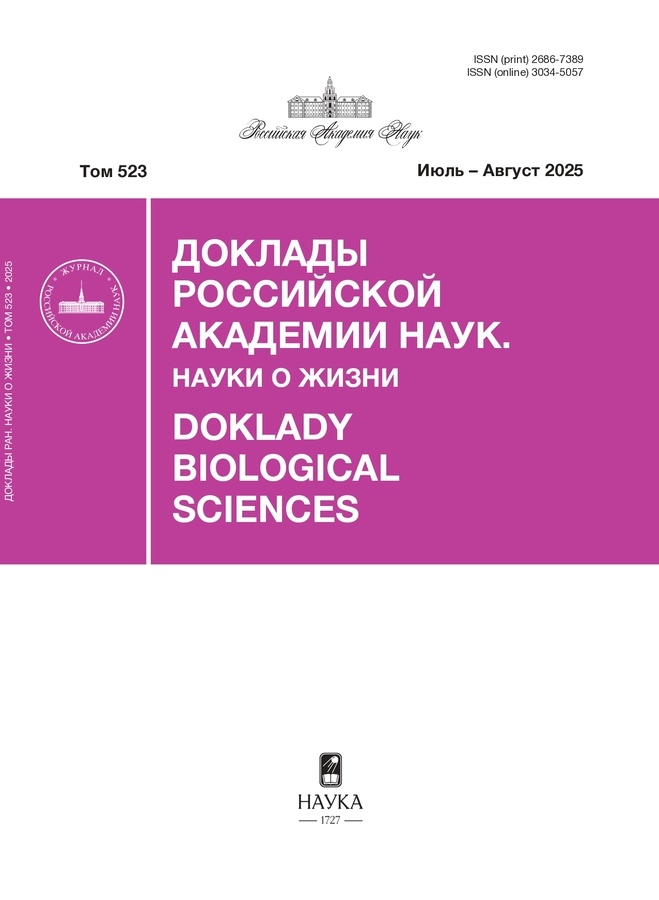Разработка и оценка эффективности мультивалентной ДНК вакцины против бруцеллеза
- Авторы: Ходарович Ю.М.1, Ельшазли М.А.2, Марзанова С.Н.3, Магомедова С.А.3, Шелл В.С.2, Нассиф С.А.2, Девришов Д.А.3, Деев С.М.4
-
Учреждения:
- ФГБУН Государственный научный центр Российской Федерации Институт биоорганической химии им. академиков М.М. Шемякина и Ю.А. Овчинникова Российской академии наук
- Центральная лаборатория по оценке ветеринарных биопрепаратов, Сельскохозяйственный научный центр
- ФГБОУ ВО “Московская государственная академия ветеринарной медицины и биотехнологии – МВА имени К.И. Скрябина”
- ФГБУН Государственный научный центр Российской Федерации Институт биоорганической химии им. академиков М.М. Шемякина и Ю.А. Овчинникова Российской академии нау
- Выпуск: Том 520, № 1 (2025)
- Страницы: 31-37
- Раздел: Статьи
- URL: https://cijournal.ru/2686-7389/article/view/682025
- DOI: https://doi.org/10.31857/S2686738925010062
- EDN: https://elibrary.ru/tcxfpl
- ID: 682025
Цитировать
Полный текст
Аннотация
Вакцинация против бруцеллеза в настоящее время проводится с использованием ослабленных штаммов живых бруцелл, что вызывает серьезные побочные эффекты у животных и малоприменимо для вакцинации людей. С целью разработки более безопасной вакцины против бруцеллеза мы создали плазмидную ДНК, способную экспрессировать шесть белков бруцеллы в клетках млекопитающих. Для повышения эффективности доставки ДНК в клетки использовали линейный полиэтиленимин. Приведены данные по оптимизации условий образования комплексов ДНК-полиэтиленимин. Показано, что однократная внутримышечная или подкожная инъекция комплексов плазмидной ДНК с полиэтиленимином в низкой дозе (20 мкг/мышь) оказывает достоверный защитный эффект от последующего заражения мышей тестовым штаммом бруцеллы.
Ключевые слова
Полный текст
Об авторах
Ю. М. Ходарович
ФГБУН Государственный научный центр Российской Федерации Институт биоорганической химии им. академиков М.М. Шемякина и Ю.А. Овчинникова Российской академии наук
Автор, ответственный за переписку.
Email: khodarovich@mail.ru
Россия, Москва
М. А. Ельшазли
Центральная лаборатория по оценке ветеринарных биопрепаратов, Сельскохозяйственный научный центр
Email: khodarovich@mail.ru
Египет, Каир
С. Н. Марзанова
ФГБОУ ВО “Московская государственная академия ветеринарной медицины и биотехнологии – МВА имени К.И. Скрябина”
Email: khodarovich@mail.ru
Россия, Москва
С. А. Магомедова
ФГБОУ ВО “Московская государственная академия ветеринарной медицины и биотехнологии – МВА имени К.И. Скрябина”
Email: khodarovich@mail.ru
Россия, Москва
В. С. Шелл
Центральная лаборатория по оценке ветеринарных биопрепаратов, Сельскохозяйственный научный центр
Email: khodarovich@mail.ru
Египет, Каир
С. А. Нассиф
Центральная лаборатория по оценке ветеринарных биопрепаратов, Сельскохозяйственный научный центр
Email: khodarovich@mail.ru
Египет, Каир
Д. А. Девришов
ФГБОУ ВО “Московская государственная академия ветеринарной медицины и биотехнологии – МВА имени К.И. Скрябина”
Email: khodarovich@mail.ru
член-корреспондент РАН
Россия, МоскваС. М. Деев
ФГБУН Государственный научный центр Российской Федерации Институт биоорганической химии им. академиков М.М. Шемякина и Ю.А. Овчинникова Российской академии нау
Email: khodarovich@mail.ru
академик РАН
Россия, МоскваСписок литературы
- Pappas, G., Papadimitriou, P., Akritidis, N., et al., The new global map of human brucellosis, Lancet Infect. Dis. 2006. Vol. 6, № 2, Р. 91–99.
- Pappas, G., Akritidis, N., Bosilkovski, M., and Tsianos, E., Brucellosis, N. Engl. J. Med. 2005. Vol. 352. № 22, Р. 2325–2336.
- Xie, J., Wang, J., Li, Z., ey al., Ontology-Based Meta-Analysis of Animal and Human Adverse Events Associated With Licensed Brucellosis Vaccines, Front. Pharmacol. Med. 2005. Vol. 352. № 22. P. 503.
- Ivanov, A.V., Salmakov, K.M., Olsen, S.C., Plumb, G.E., A live vaccine from Brucella abortus strain 82 for control of cattle brucellosis in the Russian Federation, Anim. Health. Res. Rev. 2011. Vol. 12, № 1. Р. 113–121.
- Девришов, Д.А., Ельшазли, М.А., Антигенная активность рекомбинантных ДНК B. melitensis Rev-1, Ветеринария, зоотехния и биотехнология. 2019. № 10. С. 7–14.
- Yu, D.H., Hu, X.D., and Cai, H., A combined DNA vaccine encoding BCSP31, SOD, and L7/L12 confers high protection against Brucella abortus 2308 by inducing specific CTL responses, DNA Cell Biol. 2007. Vol. 26, № 6. P. 435–443.
- Casper, J., Schenk, S.H., Parhizkar, E., et al., Polyethylenimine (PEI) in gene therapy: Current status and clinical applications, J. Control. Release. 2023. Vol. 362. Р.667–691.
- Ito, T., Yoshihara, C., Hamada, K., and Koyama, Y., DNA/polyethyleneimine/hyaluronic acid small complex particles and tumor suppression in mice, Biomaterials. 2010. Vol. 31. № 10. Р. 2912–2918.
- Sharma, V.K., Thomas, M., Klibanov, A.M., Mechanistic studies on aggregation of polyethylenimine-DNA complexes and its prevention, Biotechnol. Bioeng. 2005. Vol. 90. № 5. Р. 614–620.
Дополнительные файлы













